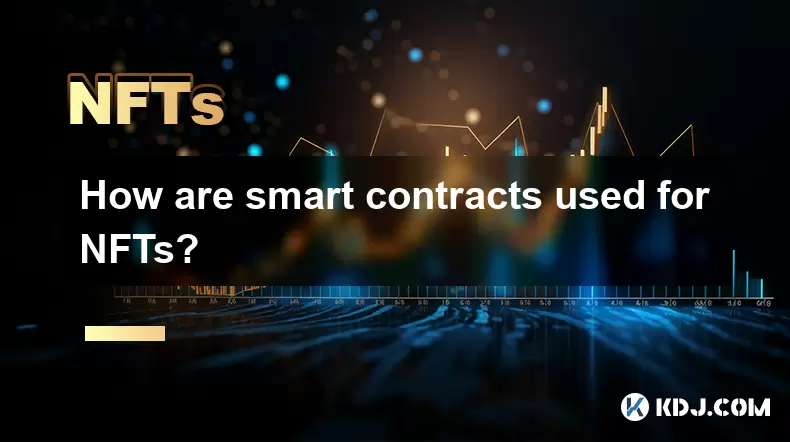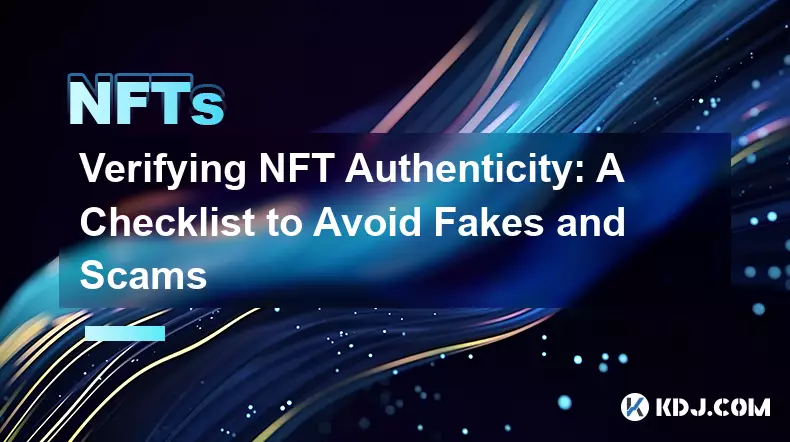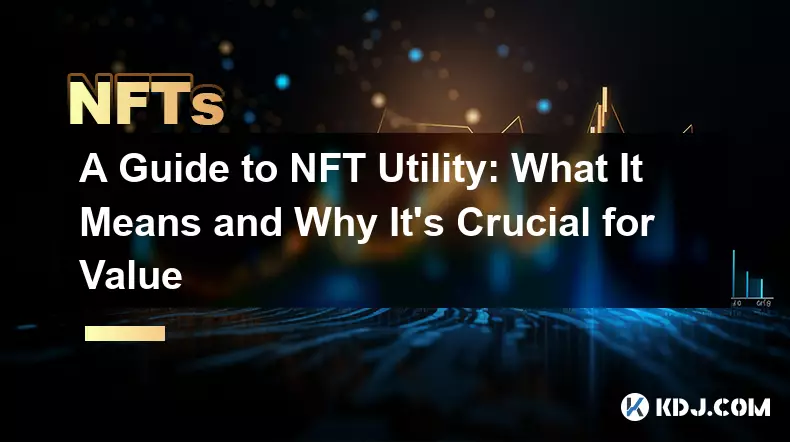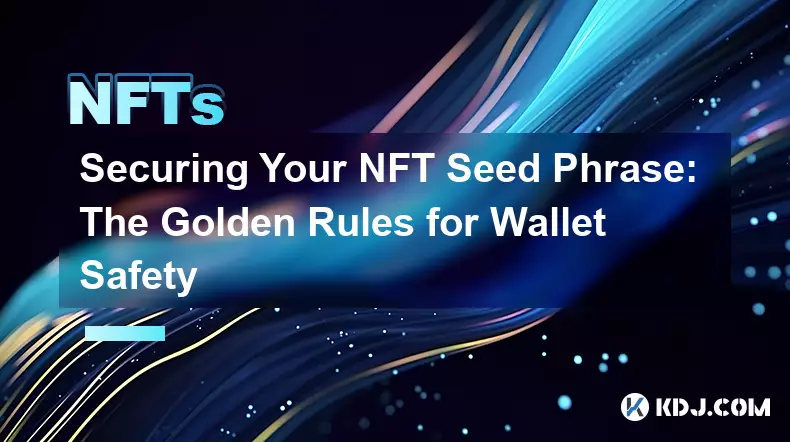-
 bitcoin
bitcoin $107015.826941 USD
-2.18% -
 ethereum
ethereum $3637.352324 USD
-5.18% -
 tether
tether $0.999831 USD
-0.02% -
 xrp
xrp $2.338078 USD
-6.23% -
 bnb
bnb $998.272150 USD
-6.97% -
 solana
solana $167.598257 USD
-10.12% -
 usd-coin
usd-coin $0.999863 USD
0.01% -
 tron
tron $0.282573 USD
-5.09% -
 dogecoin
dogecoin $0.169891 USD
-7.39% -
 cardano
cardano $0.557554 USD
-7.03% -
 hyperliquid
hyperliquid $39.914802 USD
-5.85% -
 chainlink
chainlink $15.414549 USD
-9.97% -
 bitcoin-cash
bitcoin-cash $510.361911 USD
-4.26% -
 ethena-usde
ethena-usde $0.999194 USD
-0.03% -
 stellar
stellar $0.282092 USD
-6.07%
How are smart contracts used for NFTs?
Smart contracts enable NFTs by defining ownership, ensuring uniqueness, and automating royalties through self-executing code on blockchains like Ethereum.
Aug 10, 2025 at 06:01 pm

Understanding the Role of Smart Contracts in NFT Creation
Smart contracts serve as the foundational technology enabling the existence and functionality of NFTs (Non-Fungible Tokens). These self-executing digital agreements, written in code and deployed on blockchain networks like Ethereum, define the rules and behaviors of NFTs. When an NFT is created, or 'minted,' a smart contract is used to assign a unique identifier to a specific digital asset, ensuring its uniqueness and ownership. This process involves encoding metadata such as the asset’s name, description, and file URI into the blockchain via the contract. The immutability of the blockchain ensures that once this information is recorded, it cannot be altered, providing a verifiable and permanent record of authenticity.
The most widely used standard for NFTs on Ethereum is the ERC-721 token standard, which is implemented through smart contracts. Each NFT created under this standard is distinct and not interchangeable with another, unlike fungible tokens such as ETH. The smart contract governs how the NFT can be transferred, who owns it, and whether it can be duplicated. Developers deploy these contracts to the blockchain, and users interact with them through wallets or NFT marketplaces to mint, buy, or sell digital collectibles.
How Smart Contracts Enable NFT Ownership and Transfer
Ownership of an NFT is managed entirely through the logic embedded in the smart contract. The contract maintains a mapping of token IDs to wallet addresses, effectively tracking who owns which NFT. When a user purchases or receives an NFT, the transaction triggers the smart contract to update this mapping. This transfer process is trustless and transparent, as every action is recorded on the blockchain and can be publicly verified.
To transfer an NFT from one wallet to another:
- The sender must initiate a transaction calling the transferFrom() function within the smart contract.
- The function verifies that the sender is the current owner of the token.
- It checks whether the sender has approved the transaction, either directly or through a marketplace contract.
- Upon validation, the contract updates the ownership record and emits a Transfer event logged on the blockchain.
This mechanism eliminates the need for intermediaries. The smart contract autonomously enforces ownership rules, ensuring that only the rightful owner can initiate a transfer. Moreover, because the contract is open-source, anyone can audit its code to confirm that it operates as intended.
Embedding Royalties and Licensing via Smart Contracts
One of the transformative features of NFTs is the ability for creators to earn royalties on secondary sales, which is enforced through smart contracts. Traditionally, artists lose control over their work after the initial sale, but NFT smart contracts can include logic that automatically pays a percentage of future resale proceeds back to the original creator.
To implement royalties:
- The smart contract includes a royalty percentage and the creator’s wallet address during the minting phase.
- When a secondary sale occurs on a compatible marketplace, the marketplace contract queries the NFT’s smart contract for royalty details.
- The payment is split accordingly, with a portion sent to the seller and the remainder routed to the creator’s address.
This process is automated and cannot be bypassed in compliant marketplaces. The EIP-2981 standard formalizes this functionality, allowing different platforms to uniformly read and enforce royalty payments. As a result, artists and content creators gain sustainable income from their digital works without relying on legal enforcement.
Interoperability and Utility in Decentralized Applications
Smart contracts allow NFTs to be more than just digital collectibles—they can serve functional roles in decentralized applications (dApps). For example, an NFT representing a character in a blockchain-based game can be programmed with attributes and abilities stored in the smart contract. When the game dApp interacts with the NFT, it reads these attributes to determine gameplay mechanics.
Smart contracts enable such interoperability by:
- Exposing readable functions that return metadata or traits associated with the NFT.
- Supporting approval mechanisms that allow dApps to use the NFT temporarily (e.g., for staking or borrowing).
- Integrating with other smart contracts, such as lending platforms, where an NFT can be used as collateral.
In a staking scenario:
- The user approves the staking contract to access their NFT.
- They call the stake() function, which transfers the NFT into the staking contract’s custody.
- The staking contract records the deposit and begins distributing rewards based on time or activity.
The NFT remains owned by the user, but its usage is governed by the rules defined in the interacting smart contracts. This expands the utility of NFTs beyond static ownership into dynamic participation within digital ecosystems.
Security and Verification of NFT Smart Contracts
The integrity of NFTs depends heavily on the security of their underlying smart contracts. Vulnerabilities in contract code can lead to theft, unauthorized minting, or loss of funds. Therefore, developers must follow best practices when writing and deploying NFT contracts.
Critical security measures include:
- Conducting third-party audits of the contract code before deployment.
- Using well-tested libraries such as OpenZeppelin for implementing ERC-721 or ERC-1155 standards.
- Enabling pause mechanisms to halt contract functions in case of an emergency.
- Implementing access controls to restrict sensitive functions (e.g., minting) to authorized addresses.
Once deployed, the contract’s source code can be verified on platforms like Etherscan, allowing users to confirm that the on-chain code matches the published version. This transparency builds trust, as buyers can inspect the contract to ensure it doesn’t contain malicious functions.
Frequently Asked Questions
Can a smart contract be updated after an NFT is minted?Smart contracts are typically immutable once deployed, meaning their code cannot be altered. However, some contracts are designed with upgradeable proxy patterns, allowing certain functions to be updated without changing the core logic. This requires careful implementation to avoid compromising security.
What happens if a smart contract has a bug after NFTs are issued?If a critical bug exists, developers may need to deploy a new contract and migrate existing NFTs. This process involves users approving the transfer of their NFTs to the new contract, which can be complex and risky. In some cases, projects offer replacements or refunds to affected users.
How do I verify the authenticity of an NFT’s smart contract?You can check the contract address on a blockchain explorer like Etherscan. Look for a verified contract badge and review the code for known standards (e.g., ERC-721). You can also confirm if reputable entities have audited the contract and whether it has been used in established marketplaces.
Can NFTs exist without smart contracts?No. NFTs rely entirely on smart contracts to define their properties, ownership, and transferability. Without a smart contract, there would be no mechanism to enforce uniqueness or record ownership on a blockchain.
Disclaimer:info@kdj.com
The information provided is not trading advice. kdj.com does not assume any responsibility for any investments made based on the information provided in this article. Cryptocurrencies are highly volatile and it is highly recommended that you invest with caution after thorough research!
If you believe that the content used on this website infringes your copyright, please contact us immediately (info@kdj.com) and we will delete it promptly.
- ADA Slowdown, Maxi Doge, and the Meme Coin Mania: What's the Hype?
- 2025-11-04 20:50:12
- Ethereum, Crypto, and the $1 Target: A New Era?
- 2025-11-04 21:00:12
- Zone Nine: Nihilation - A Deep Dive into the Zombie Survival Closed Playtest
- 2025-11-04 21:10:12
- Trust Wallet VIP Program: TWT Powers a New Era of User Loyalty
- 2025-11-04 21:05:01
- Stewards Inc., Token-for-Equity, and the Dolomite PIPE: A New Era for Digital Asset Treasury
- 2025-11-04 21:05:14
- Meme Coins, Degen Alpha, and Market Updates: Riding the Crypto Wave in Style
- 2025-11-04 21:10:02
Related knowledge

The Complete Guide to NFT Whitelists: Strategy for Gaining Access
Nov 03,2025 at 02:36pm
Decentralized Exchanges Gain Momentum in 20241. Decentralized exchanges (DEXs) have seen a significant rise in trading volume, surpassing centralized ...

Verifying NFT Authenticity: A Checklist to Avoid Fakes and Scams
Nov 01,2025 at 03:55pm
Understanding the Foundations of NFT Verification1. Every NFT is built on a blockchain, most commonly Ethereum, Solana, or Polygon. The blockchain pro...

Polygon (Matic) NFT Guide: Why It's a Top Choice for Low-Fee Trading
Nov 02,2025 at 06:36pm
Bitcoin's Role in Decentralized Finance1. Bitcoin remains the cornerstone of decentralized finance, serving as a primary store of value within the cry...

A Guide to NFT Utility: What It Means and Why It's Crucial for Value
Nov 01,2025 at 12:54am
Understanding NFT Utility in the Digital Economy1. NFT utility refers to the functional value that a non-fungible token provides beyond its existence ...

Securing Your NFT Seed Phrase: The Golden Rules for Wallet Safety
Nov 03,2025 at 09:54pm
Understanding the Importance of Your NFT Seed Phrase1. The seed phrase, typically a sequence of 12 or 24 words, acts as the master key to your digital...

NFT Display Solutions: A Guide to Showcasing Your Digital Collection
Nov 01,2025 at 09:54pm
NFT Display Solutions: A Guide to Showcasing Your Digital CollectionDigital art and collectibles have become central to the cryptocurrency ecosystem, ...

The Complete Guide to NFT Whitelists: Strategy for Gaining Access
Nov 03,2025 at 02:36pm
Decentralized Exchanges Gain Momentum in 20241. Decentralized exchanges (DEXs) have seen a significant rise in trading volume, surpassing centralized ...

Verifying NFT Authenticity: A Checklist to Avoid Fakes and Scams
Nov 01,2025 at 03:55pm
Understanding the Foundations of NFT Verification1. Every NFT is built on a blockchain, most commonly Ethereum, Solana, or Polygon. The blockchain pro...

Polygon (Matic) NFT Guide: Why It's a Top Choice for Low-Fee Trading
Nov 02,2025 at 06:36pm
Bitcoin's Role in Decentralized Finance1. Bitcoin remains the cornerstone of decentralized finance, serving as a primary store of value within the cry...

A Guide to NFT Utility: What It Means and Why It's Crucial for Value
Nov 01,2025 at 12:54am
Understanding NFT Utility in the Digital Economy1. NFT utility refers to the functional value that a non-fungible token provides beyond its existence ...

Securing Your NFT Seed Phrase: The Golden Rules for Wallet Safety
Nov 03,2025 at 09:54pm
Understanding the Importance of Your NFT Seed Phrase1. The seed phrase, typically a sequence of 12 or 24 words, acts as the master key to your digital...

NFT Display Solutions: A Guide to Showcasing Your Digital Collection
Nov 01,2025 at 09:54pm
NFT Display Solutions: A Guide to Showcasing Your Digital CollectionDigital art and collectibles have become central to the cryptocurrency ecosystem, ...
See all articles










































































